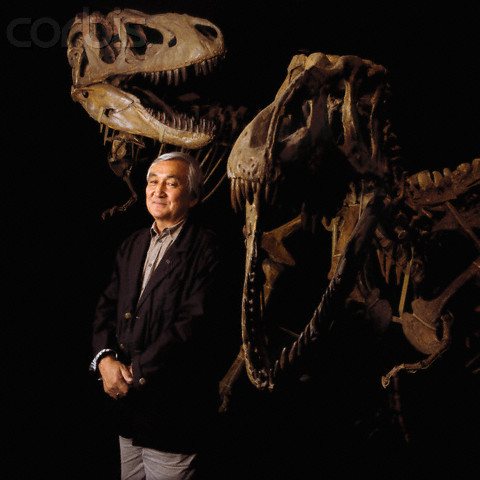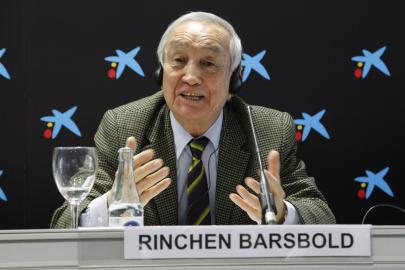Dr. Rinchen Barsbold born December 21, 1935 in Ulan Bator is a Mongolian paleontologist and geologist. He works with the Institute of Geology, at Ulaanbaatar, Mongolia. He is recognized around the world as a leader in vertebrate paleontology and Mesozoic stratigraphy.
Barsbold has been instrumental in the discovery and recovery of one of the largest dinosaur collections in the world. His work has projected Mongolian paleontology into world prominence and helped to form a more modern understanding of the later stages of dinosaur evolution in Eurasia.
Barsbold has had considerable influence on dinosaur paleontology in the Communist world. Barsbold’s scientific work has made him a leading authority on theropods of the Gobi Desert, starting with his doctoral dissertation on these dinosaurs. As early as 1983, he noted that in different lineages of theropods, many features hitherto only known from birds had evolved in various combinations (Barsbold 1983). He postulated that as a result of this “ornithization”, one or several lineages of theropods that happened to acquire the proper combination of such traits went on to evolve into actual birds.
Since the identification of a number of feathered dinosaurs beginning in the late 1990s, Barsbold’s ideas are more fully appreciated. When he initially published his conclusions – a list of generally rather obscure anatomical features – in 1983, there was little exchange between the Mongolian scientific community and that of Western countries. Moreover, Barsbold’s early papers were usually published in Russian, in which few Western scientists are fluent. In addition, Evgeny Kurochkin – probably the leading specialist on bird paleontology in the then-Communist world – was critical of the theropod-bird link, working with and teaching mostly Cenozoic bird paleontology. Therefore, Barsbold’s theories initially had more impact among “dinosaur” paleontologists in Mongolia, the USSR, and allied countries.
2010 Romer-Simpson Medal Recipient Rinchen Barsbold Wrote…….
“I was born (1935.12.21) in the capital of Mongolia, Ulaanbaatar city, or UB as its’s well-known among the foreigners who have now visited our country. During the most of 20th century my country has been “defended” by the iron curtain from the west and east, and, probably, UB appeared as an abbreviated name only after 1990 while Gorbachev’s perestroika had changed the situation that now seems to be so stable and steady. Hopefully, our Mongolia is now quite free and democratic country.
But my field research at the Gobian dinosaur sites started long before these remarkable changes took place. Being the leader of the Joint Mongolian-Soviet expeditions, I had the best possibilities to research many times all the great dinosaur sites over the Gobi Desert, and to include notable fossils into the Mongolian Dinosaur Collection, which is well-known in the world. During that time in Warsaw, thanks to the efforts of Z.Kielan-Jaworowska, an outstanding scientist and 1995 Romer-Simpson Medalist, I had a happy opportunity to meet J.H. Ostrom, who worked out his idea on the bird ancestry. Many years after the iron curtain had been taken off, I met again the great scientist in his Peabody Museum. We were no longer so young, and the meeting was very sincere and touching. Ostrom has advanced our knowledge on the dinosaur evolution, having opened the new approaches to the fruitful “dinosaur-bird” concept, a remarkable achievement of the evolutionary biology at the end of 20th century. I dare think that researchers in the Mongolian Gobi are not only simple eye-witnesses, but may also have promoted, even a little, this remarkable concept. Indeed, the divergence and unique state of preservation so characteristic of the Mongolian fossil record allow us to show a number of unusual aspects in the dinosaur morphology, and even to open slightly this fundamental and hidden sphere of the behavior of dinosaurs. Surely, the Fighting Dinosaurs, the Flock of Protoceratops babies, as well as Oviraptorid Citipati in brooding position say much about the dinosaur behavioral aspects, which were absolutely unknown in the science of the last century.
I always keep in mind R.C. Andrews’ words: “Mongolia, a land of mystery, of paradox and promise!” Our friendly cooperations with the colleagues from US, Japan, South Korea, Canada, China, as well as with our old friends from Russia and Poland, have extended the possibilities of the Mongolian Paleontology in which my collaborators and I live. I have had a happy chance to work in many joint expeditions being always their indispensable participant. Now we here understand more deeply the ancient history of the past wild nature of Mongolia and Central Asia as a whole. We see the similarity of the Mongolian dinosaurs with the North American relative groups, and their difference from the Chinese dinosaurs, even though our countries are close neighbours. The great dinosaur sites of the Mongolian Gobi preserve their mystery, paradox and promise. Let’s work further! “



 April 17th, 2013
April 17th, 2013  Riffin
Riffin 

 Posted in
Posted in  Tags:
Tags: 